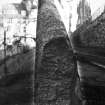Edinburgh, University Of Edinburgh, George Square
Rune Inscribed Stone (Early Medieval)
Site Name Edinburgh, University Of Edinburgh, George Square
Classification Rune Inscribed Stone (Early Medieval)
Alternative Name(s) William Robertson Building; Edinburgh Runestone; Sweden, Uppland, Vittinge, Lilla RamsjÖ; U1173
Canmore ID 52498
Site Number NT27SE 45
NGR NT 25988 72938
Datum OSGB36 - NGR
Permalink http://canmore.org.uk/site/52498
- Council Edinburgh, City Of
- Parish Edinburgh (Edinburgh, City Of)
- Former Region Lothian
- Former District City Of Edinburgh
- Former County Midlothian
Princes Street Gardens, Edinburgh, Swedish runestone
Measurements: H 1.36m above ground level, W 1.00m, D 0.38>0.08m at the top
Stone type: granite
Place of discovery: Little Ramsingarde, Westmanland, Sweden.
Proposed location: to be set upright in a small garden on the south side of 50 George Square, Edinburgh.
Evidence for discovery: brought from Sweden and presented to the Society of Antiquaries of Scotland by Alexander Seton before 1822. It was set upright below the Castle Esplanade in the south-east corner of Princes Street Garden. it was removed by excavation in 2017, conserved and re-sited off George Square in 2019.
Present condition: weathered and damaged at the top. The carving has been picked out in red paint.
Description
This substantial 1.3 ton boulder has been carefully dressed to a flat surface on one broad face, leaving the others very rough. Deeply incised on dressed face A is a cross with expanded wedge-shaped arms, a central ring and triangles between the arms. The shaft terminates in an expanded point, which is ‘tied’ by bands to the ends of a ribbon bearing an inscription in runes, which reads ‘Ari put up this stone in memory of his father Hjálm. God help his soul.’ At some period the runic letters have been picked out in red paint. The lower part of face B appears to have been slightly dressed and bears a roughly incised equal-armed outline cross with expanded arms, a central pit, and a shaft, also picked out in red paint. The style of carving on the two faces is quite different and the crosses may not be contemporary. The 1822 account of the stone states that ‘On one side of the stone, there is another figure represented on the plate, the meaning of which is not understood’, which suggests that the cross on face B may be a nineteenth-century enhancement of an original carving.
Date: eleventh century.
References: Archaeologia Scotica 2 (1822), 490-1.
Compiled by A Ritchie 2016
NT27SE 45 2527 7352.
(NT 2527 7352) Runic Stone (NAT)
OS 1/1250 map, (1970)
This runic stone, a block of granite, was brought from Little Ramsingarde, Witting parish, Westmanland, Sweden by Sir Alexander Seton and presented by him to the Society of Antiquaries of Scotland, who had it set up in its present position in Princes Street Gardens. The runes, of c. 10th century date, read "Ari engraved this stone in memory of Hialm his father. God help his soul."
(Anon 1818).
A deeply incised stone, markings outlined by red paint. Of no local archaeological value.
Visited by OS (J L D) 28 December 1953.
This stone is a facsimile and of no archaeological interest.
Visited by OS (S F S) 28 November 1975.
Project (1997)
The Public Monuments and Sculpture Association (http://www.pmsa.org.uk/) set up a National Recording Project in 1997 with the aim of making a survey of public monuments and sculpture in Britain ranging from medieval monuments to the most contemporary works. Information from the Edinburgh project was added to the RCAHMS database in October 2010 and again in 2012.
The PMSA (Public Monuments and Sculpture Association) Edinburgh Sculpture Project has been supported by Eastern Photocolour, Edinburgh College of Art, the Edinburgh World Heritage Trust, Historic Scotland, the Hope Scott Trust, The Old Edinburgh Club, the Pilgrim Trust, the RCAHMS, and the Scottish Archive Network.
Field Visit (21 August 2001)
Standing stone with incised carving on front (N.) side and on W. side. Front carved with a processional cross and a stylised serpent in which is an inscription in Swedish. Side carved with a plainer cross.
Inspected By : T. S.
Inscriptions : In Swedish, in incised lettering: [Art set up this stone in memory of Hialm his father. God help his soul!]
Signatures : None
Design period : 11th century
Information from Public Monuments and Sculpture Association (PMSA Work Ref : EDIN0964)


























